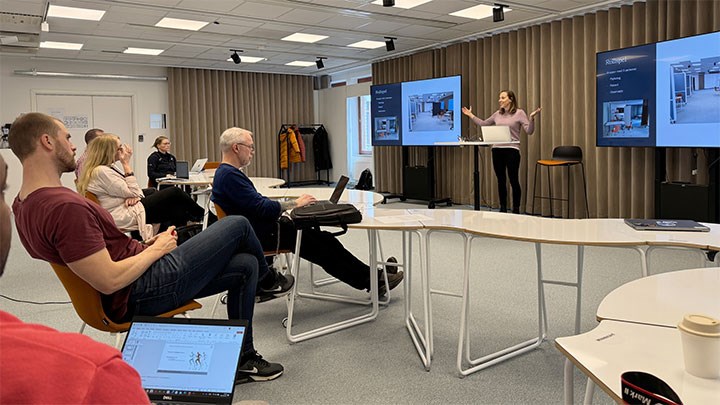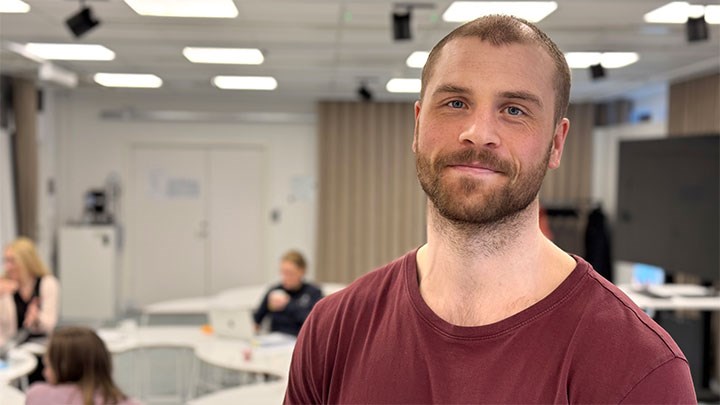Teachers at Örebro University explore flexible learning environments to activate their students

Sara Edlund discusses her approach to group work while teaching aspiring psychologists at Örebro University.
What role does the space of a room play in students’ participation and ability to learn? In the pedagogical course Flexible learning environments for student active learning, teachers at Örebro University develop their teaching with the classroom as their starting point. “I want to create conditions for motivation in the classroom,” says Patrik Gerdin, one of the course participants.
Four students half-sitting or leaning back in their chairs as they try to solve a problem. The activity level is low. Each student is given a pen and asked to stand up in front of a whiteboard.
“Suddenly, everyone becomes engaged. When everyone stands up with a pen in hand, a shift occurs within the group – and it's not just one person assuming the role of secretary.”
Magnus Hansson, a pedagogical developer at the Centre for Academic Development and docent at Örebro University’s School of Business, states that he conducts the course Flexible learning environments for student-activated learning (in Swedish), alongside Anna-Eva Olsson, who is the project coordinator as well as coordinator for learning environments at Örebro University.
Group work - in new ways
Today, participants will have the opportunity to learn about three experiences from other teachers who share how they utilise the space of a room to support various types of learning activities.
“We all know what group work is like. Everyone scatters into the corridors and study areas outside the classroom, and as the teacher, you’ll often find only half of the groups,” says Sara Edlund, who teaches in the psychology programme at Örebro University.
Sara Edlund states that she now utilises the flexible learning environment in the Learning Lab for group work and role-playing. The lab features fold-out walls, allowing the creation of distinct learning spaces within the classroom. There is ample space between groups, enabling her as a teacher to maintain an overview and remain accessible to everyone at all times.
“When a group experiences an interesting development, it’s easy to pause and share it with the entire class,” says Sara Edlund.

Activities shape how rooms are furnished
Adrian Hosford-Donovan is an anatomy teacher in the Sports Science and Coaching Programme and is studying at Örebro University to become a physical education teacher. He also allows the day’s activities to influence how the classroom is arranged.
It could involve setting up various stations in the room where students can interact with each other and with him as their teacher.
“Active learning engages students more effectively and contributes to a deeper understanding. As a teacher, I focus on creating an improved learning environment where the physical space interacts with the pedagogical and social aspects. The Learning Lab, with its flexible furnishings, excellent acoustics, and cutting-edge digital technology, has inspired me to innovate my teaching of anatomy,” says Adrian Hosford-Donovan.
Creating the right conditions for motivation in the classroom
Another participant in the course is Patrik Gerdin, who also instructs student teachers and students on the Sports Science and Coaching Programme at Örebro University. He is an upper secondary school teacher and views this course as an opportunity for his professional development.

“I’ve learnt many new tips and ideas - research-based methods that help me establish the right conditions for motivation in the classroom.”
He believes more university teachers should take the opportunity to attend the course.
“It’s an opportunity to enhance your teaching and a means to implement your perspective on teaching and learning,” says Patrik Gerdin.
“It’s important to be open to evaluating one’s own teaching.”
Chris Hedenskog, who teaches future nurses at Örebro University, is another participant. She has taken part in various learning activities within the Learning Lab, including exam seminars, and is eager to explore these flexible environments.
“When you enter the Learning Lab, it seems quite straightforward, but the longer you stay, the more you realise the possibilities for utilising the space in the room,” says Chris Hedenskog.

She sees the course as a chance to deepen her understanding of pedagogy and enhance her ability to communicate knowledge, enabling students to benefit effectively from it.
“My biggest takeaway is that, as a teacher, I need to be well-prepared with a well-thought-out goal and purpose. How the room is furnished, where I stand in the room, and when we take breaks - all of it matters. It’s important to be open to evaluating one’s own teaching,” says Christina Hedenskog.
Attracting teachers from other universities
The course targets university teachers interested in understanding how spatial, pedagogical, and social dimensions interact and influence students’ ability to acquire new knowledge. Next spring semester, it is expected that the course will also be available to teachers at other universities.
“At Örebro University, we have developed many exciting ideas in recent years about how flexible learning environments can foster student-active teaching. It would be wonderful to attract teachers from other universities to participate in the course. We all stand to gain significantly from exchanging knowledge and experience across university boundaries,” says Henric Bagerius, docent in history and head of pedagogy at the Centre for Academic Development at Örebro University.
The course Flexible learning environments for student-activated learning is organised by the Centre for Academic Development at Örebro University. It targets university teachers interested in understanding the importance and impact of spatial, pedagogical, and social dimensions in designing various learning environments. Learn more about Flexible learning environments for student-activated learning (in Swedish) here. The next course is scheduled for spring 2026.
Learning Lab serves as a test bed for the future of learning spaces and higher education pedagogy, located in Långhuset at Örebro University. Here, teachers and students collaboratively create their learning environments in flexible rooms that encourage new teaching methods and student-active learning. The Learning Lab is a partnership between Örebro University and Akademiska hus. Learn more about Learning Lab at Örebro University.
Text: Anna Lorentzon
Photo: Anna Lorentzon
Translation: Jerry Gray
